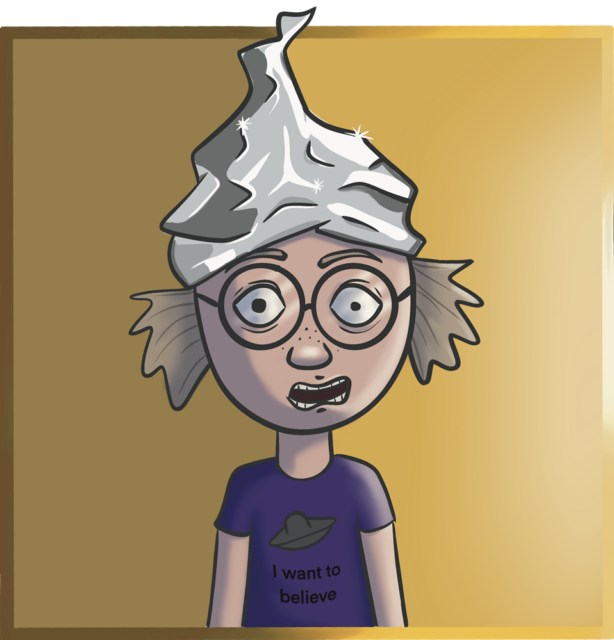Definition:
A “conspiracy” involves two or more individuals with a shared agenda collaborating in opposition to others’ interests. (Even a surprise party for someone who wouldn’t want it can be classified as a conspiracy.)
Etymology:
The word “conspiracy” comes from the Latin “conspirare,” meaning “to plot together” or “to agree by oath.” It is a combination of con- (“together”) and “spirare” (“to breathe”), which originally conveyed the sense of individuals figuratively “breathing together” in alignment with a shared scheme. The term entered Middle English through Old French as “conspiracie.”
It is worth noting that the word “conspiracy” contains the prefix “con-” which is also slang for “scam.”
Description:
The most popular misunderstanding about the word “conspiracy” is that it implies a group of powerful individuals must have gathered around a table where they discussed and planned how to deceive people. This is false. A conspiracy most often arises without shared discussion and planning, but merely out of shared animosity. The greatest form of conspiracy in the world is the dissemination of lies. The world is teeming with millions of liars with a common goal of maintaining an ignorant and gullible population. Their shared agenda is greed: they want more and more for themselves, and less for everybody else. The most popular motivation for liars is to pose themselves as special and better than others. And since they are not actually special or better than others, considering there are millions of liars like them, the only way to appear special and better than others is to create an illusion of it by suppressing others.
The vast majority of people are conditioned to believe that conspiracies are akin to fairytales and never occur, yet courts frequently handle cases involving conspiracy, demonstrating that conspiracies are not merely theoretical but are often proven in legal proceedings.
One of the most popular misunderstandings regarding how a conspiracy operates is that it requires every single person involved in its execution to be consciously aware of the conspiracy. This is false. Often, only those planning a conspiracy need to be aware of how it functions. As long as the rest only follow orders and lack access to the plan (which is often the case when they are performing paid work), they can contribute in complete ignorance.
Today, conspiracy is so widespread that the entire world system is a conspiracy.
Articles:
Big Brother
Definition: “Big Brother” is a term that refers to an authoritative or controlling figure or government that exercises oppressive surveillance and control over individuals. Etymology: The phrase “Big Brother” was…
Illuminati
Definition: “Illuminati” refers to individuals who understand how language, religion, and the world system are scams. Etymology: The term “Illuminati” originates from Latin and means “the enlightened.” It is derived…
Tower of Babel
Pieter Bruegel the Elder: The Tower of Babel (1563). Lucas van Valckenborch: Tower of Babel (1594). Gustave Doré: The Confusion of Tongues. Definition: The “Tower of Babel,” also known as…
Conspiracy Theory:
A conspiracy theory is simply a theory proposing that a conspiracy has taken place. However, through propaganda and cultural conditioning, most people have come to equate “conspiracy theory” with an irrational or absurd hypothesis about secret plots orchestrated by an “evil government.” This association is misleading. A theory is not the same as a hypothesis—it is a structured explanation based on evidence and facts. In contrast to other widely accepted yet unproven beliefs, such as those found in religion, theories involving conspiracies are often dismissed with remarkable speed, regardless of their merit.
History offers numerous examples of conspiracies that were initially dismissed as mere “theories” but were later proven to have actually happened. The Watergate scandal, for instance, began as an accusation that seemed outlandish but eventually unraveled into a well-documented conspiracy, resulting in the resignation of a U.S. president. COINTELPRO exposed a covert FBI operation that spied on and undermined civil rights leaders, anti-war activists, and political dissidents—another example of a dismissed theory later proved accurate. Operation Northwoods revealed declassified plans by U.S. military officials to stage false-flag attacks to justify war with Cuba, showcasing how extreme and manipulative some conspiracies can be. Additionally, the infamous Tuskegee Syphilis Study involved government agencies deceiving African American men into thinking they were receiving treatment for syphilis while secretly studying the progression of the untreated disease, a conspiracy hidden for decades before public outrage forced its acknowledgment.
These cases remind us that skepticism toward conspiracy theories should not lead to outright dismissal without evidence. While not all conspiracy theories are valid, dismissing them wholesale risks ignoring genuine instances of collusion and wrongdoing.
Critical thinking is essential when evaluating such theories. A balanced approach involves assessing the evidence, considering alternative explanations, and distinguishing between theories grounded in facts and those based purely on speculation. In a world where both legitimate conspiracies and misinformation exist, careful examination is crucial.
In a web exclusive from “Last Week Tonight with John Oliver” about YouTube conspiracy videos, John Oliver goes out of his way to illustrate how conspiracy theories are constructed. The main joke of the skit is to draw connections between seemingly unrelated things or events, presenting them as part of a larger, fabricated narrative. While it is true that many YouTube conspiracy videos employ this method, and that many conspiracies may sound implausible to someone unfamiliar with the structure of symbolism, this portrayal oversimplifies and misrepresents how genuine theories are formulated.
This video serves as a clear example of propaganda, aiming to condition viewers to dismiss all conspiracy theories as absurd or unfounded. Instead of examining the reasoning or evidence behind legitimate theories, it teaches viewers to automatically discredit any form of conspiratorial thought. Such a portrayal simplifies complex discussions and discourages critical thinking, reducing nuanced ideas to oversimplified jokes for the sake of entertainment.
Click to watch the video clip.
Conspiracy Theorist:
A conspiracy theorist is someone who creates or subscribes to a conspiracy theory.
We’ve all been informed by authority that there are completely insane sadistic people in the world. We’ve all been informed by authority that there are extremely violent gangs in the world. We’ve all been informed by authority that the authorities do things they’re not supposed to tell the population. But as soon as you float the idea that the world’s most powerful people have gathered, and that they might have a plan on how to exploit the population: “That never happens. You’re crazy! You’re a damn conspiracy theorist!”
The term “conspiracy theorist” is very often confused with the words “Republican” or “Christian,” as Republicans tend to shout the loudest against authority as long as it’s not their own party in charge, and because most Republicans are Christians, which is why they speak out against established science. The fact that these people have such overtly superstitious arguments has resulted in scientists and the left side of politics in general tending to build strawman arguments against all criticism of authority and the scientific community, assuming that anyone who criticizes authority must be religious.
We are constantly told through propaganda that “conspiracy theorist” means “crazy.” Conspiracy theorist is often used as a pejorative label to discredit anyone who questions authority. This is so widespread that the image that comes to people’s minds when they hear “conspiracy theorist” is a paranoid person with aluminum foil hat on their head.

A very good example of how conspiracy theorists are so easily dismissed as crazy is from a debate on “Politically Incorrect” (2001-05-16) where George Carlin begins to explain how powerful elites—the “owners of the country”—manipulate elections and policy to maintain control. Using vivid imagery, Carlin describes these elites as “driving the bus” while the public is relegated to “the back.” His critique is sharp, highlighting systemic corruption and the consolidation of power. However, Horace Cooper’s immediate dismissal of Carlin’s points reveals the depth of societal conditioning that leads individuals to reflexively reject the notion of systemic conspiracies.
Cooper interrupts Carlin’s argument with a dismissive remark: “Back to earth for you now,” framing Carlin’s observations as detached from what is considered reasonable or grounded. This response sets the tone for Cooper’s follow-up statement: “There is no national conspiracy to buy elections and control America.” Rather than engaging with Carlin’s critique or addressing its substance with counter-evidence, Cooper’s flat denial operates as if the mere declaration of nonexistence invalidates the argument entirely.
Click to watch the video clip.
Most people who insist that conspiracies never happen tend to never engage in debate with conspiracy theorists. At the same time, they claim that conspiracy theorists accept conspiracy theories because they are too intellectually lazy to figure out how the world actually works. A good example of this is from an interview of David Icke on BBC’s “This Week” (2016-05-19). During the discussion, Michael Portillo states that he believes conspiracy theorists are intellectually lazy. In response, David Icke asks Portillo if he has read his last book, which spans over a thousand pages. Portillo admits that he has not read it, exposing his hypocrisy in labeling conspiracy theorists as intellectually lazy. His claim demonstrates his own intellectual laziness, as he made the accusation without having read the book, as he would not have called conspiracy theorists intellectually lazy had he read the book. Click to watch the video clip.
Symbolism:
Articles:
Eye
Definition: The “eye” is a complex sensory organ responsible for vision. It detects light and converts it into electrochemical signals, which are then processed by the brain to produce images….
Illuminati
Definition: “Illuminati” refers to individuals who understand how language, religion, and the world system are scams. Etymology: The term “Illuminati” originates from Latin and means “the enlightened.” It is derived…
Pyramid
Definition: A “pyramid” is a geometric shape with a polygonal base and triangular sides meeting at a single apex. Etymology: The term “pyramid” originates from the Greek word “pyramis,” meaning…
Tower of Babel
Pieter Bruegel the Elder: The Tower of Babel (1563). Lucas van Valckenborch: Tower of Babel (1594). Gustave Doré: The Confusion of Tongues. Definition: The “Tower of Babel,” also known as…


